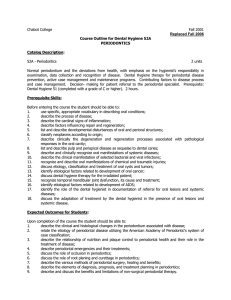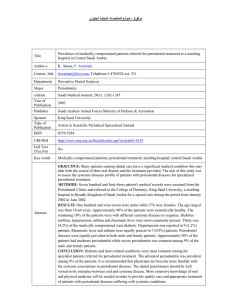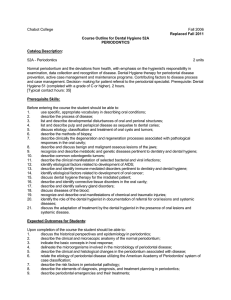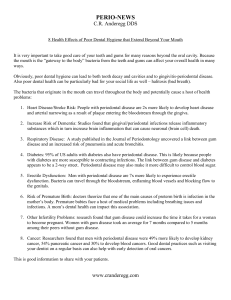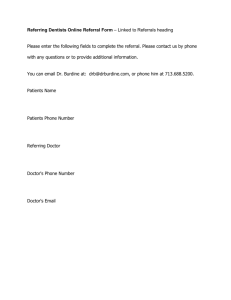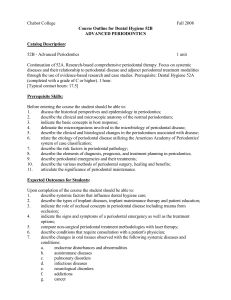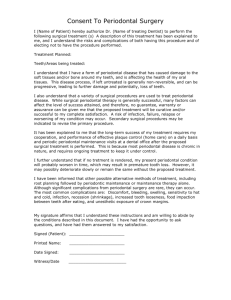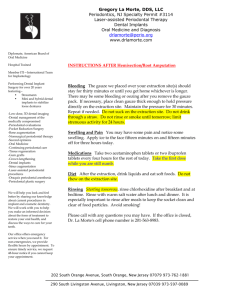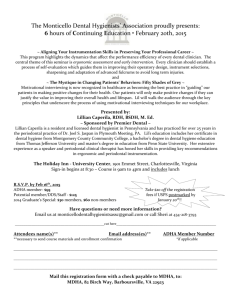Advanced Periodontics
advertisement
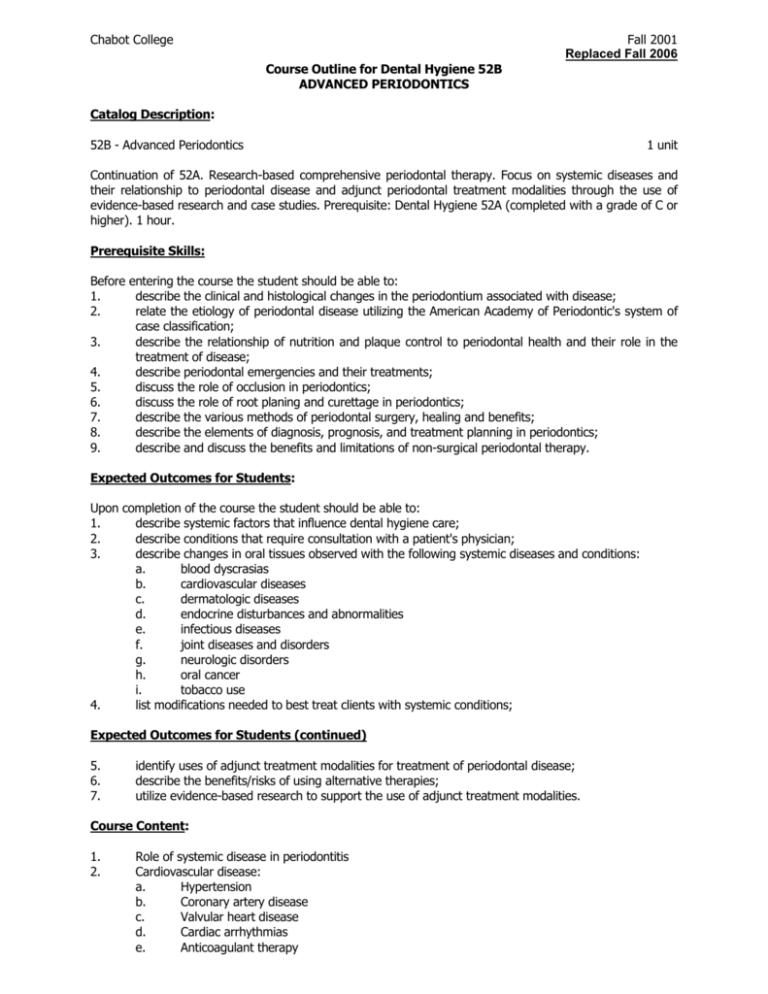
Chabot College Fall 2001 Replaced Fall 2006 Course Outline for Dental Hygiene 52B ADVANCED PERIODONTICS Catalog Description: 52B - Advanced Periodontics 1 unit Continuation of 52A. Research-based comprehensive periodontal therapy. Focus on systemic diseases and their relationship to periodontal disease and adjunct periodontal treatment modalities through the use of evidence-based research and case studies. Prerequisite: Dental Hygiene 52A (completed with a grade of C or higher). 1 hour. Prerequisite Skills: Before entering the course the student should be able to: 1. describe the clinical and histological changes in the periodontium associated with disease; 2. relate the etiology of periodontal disease utilizing the American Academy of Periodontic's system of case classification; 3. describe the relationship of nutrition and plaque control to periodontal health and their role in the treatment of disease; 4. describe periodontal emergencies and their treatments; 5. discuss the role of occlusion in periodontics; 6. discuss the role of root planing and curettage in periodontics; 7. describe the various methods of periodontal surgery, healing and benefits; 8. describe the elements of diagnosis, prognosis, and treatment planning in periodontics; 9. describe and discuss the benefits and limitations of non-surgical periodontal therapy. Expected Outcomes for Students: Upon completion of the course the student should be able to: 1. describe systemic factors that influence dental hygiene care; 2. describe conditions that require consultation with a patient's physician; 3. describe changes in oral tissues observed with the following systemic diseases and conditions: a. blood dyscrasias b. cardiovascular diseases c. dermatologic diseases d. endocrine disturbances and abnormalities e. infectious diseases f. joint diseases and disorders g. neurologic disorders h. oral cancer i. tobacco use 4. list modifications needed to best treat clients with systemic conditions; Expected Outcomes for Students (continued) 5. 6. 7. identify uses of adjunct treatment modalities for treatment of periodontal disease; describe the benefits/risks of using alternative therapies; utilize evidence-based research to support the use of adjunct treatment modalities. Course Content: 1. 2. Role of systemic disease in periodontitis Cardiovascular disease: a. Hypertension b. Coronary artery disease c. Valvular heart disease d. Cardiac arrhythmias e. Anticoagulant therapy Chabot College Course Outline for Dental Hygiene 52B, Page 2 Fall 2001 3. 4. 5. 6. 7. 8. 9. 10. 11. Joint disorders: a. Arthritis b. Artificial joints Endocrine disturbances/abnormalities a. Diabetes b. Pregnancy c. Hormone therapy Infectious diseases a. Viral hepatitis b. Acquired immune deficiency syndrome c. Herpes simplex d. Human papilloma virus Dermatologic diseases a. Lichen planus Oral cancer Blood dyscrasias a. Aplastic anemia b. Agranulocytosis c. Cyclic neutropenia d. Leukemias Neurologic disorders a. Phenytonin - influence on gingival enlargement Tobacco use and periodontal disease Alternative periodontal therapies a. Use of antimicrobials b. Use of antibiotics Methods of Presentation: 1. 2. 3. Lecture Discussion Case studies Assignments and Methods of Evaluating Student Progress: 1. 2. Typical Assignments a. Class participation b. Analysis of a case documentation for a periodontally advanced case type c. Evaluation of a research article focusing on periodontal therapy/treatment modalities. d. Development of a qualitative research project Methods of Evaluating Student Progress a. Quizzes b. Midterm examination c. Final examination Textbook(s)(Typical): Periodontology for the Dental Hygienist, Perry, Beemsterboer, & Taggart, W.B. Saunders, 1996 Special Student Materials: Diskettes tms, Disk 20, A:\DH Outlines 2000\DH 52B Revised: 12/1/00

